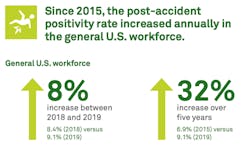Workforce Drug Use Hits 16 Year High: Research
The rate of workforce drug positivity hit a sixteen-year high in 2019, according to Quest Diagnostics. Positivity rates in the combined U.S. workforce increased in urine drug tests, climbing to the highest level since 2003 (4.5 percent) and more than 28 percent higher than the thirty-year low of 3.5 percent recorded between 2010 and 2012.
In addition to overall increases in workforce drug positives, specific regions of the United States, particularly the Midwest, experienced dramatic increases in positivity for cocaine and methamphetamine as well as marijuana.
The Quest Diagnostics Drug Testing Index, which include an analysis of industry-specific data, generally align with other research, according to the firm. Drug deaths in the United States rose 5 percent in 2019, driven largely by methamphetamine, cocaine, and fentanyl, following a decline in 2018. During the first few months of 2020, drug deaths increased about 13 percent compared with last year, attributable partly to social isolation and other disruptions caused by Covid-19.
“There is no question that before Covid-19, rates of workplace drug positivity were trending in the wrong direction, based on our Quest Diagnostics data,” said Dr. Barry Sample, senior director of science and technology, in a prepared statement. “The enormous strain caused by Covid-19 may prove to be an accelerant on this disturbing trend. Organizations will need to consider the impact of Covid-19 not only on workplace safety but also as a health concern for their employees for some time to come.”
Methamphetamine surge in Midwest
Over the last five years, methamphetamine positivity in the general U.S. workforce testing increased nearly 12 percent, from 0.17 percent in 2015 to 0.19 percent in 2019. The Midwest region experienced year-over-year increases, driven primarily by double-digit increases in the East North Central region during this period. Over the past five years, methamphetamine positivity in the Midwest increased nearly 78 percent (0.09 percent in 2015 to 0.16 percent in 2019). Illinois, Indiana, Michigan, and Ohio increased at least two-fold; Wisconsin nearly doubled.
“While the national debate on drug misuse in the workforce has focused primarily on marijuana, increasing positivity rates for cocaine and methamphetamine are also cause for concern,” said Dr. Sample. “Positivity by drug and region can be random and unpredictable. Our data is a reminder that it is important to remain vigilant about all drug misuse in the workforce.”
Between 2019 and 2018, methamphetamine positivity inched up nearly 6 percent (0.18 percent in 2018 to 0.19 percent in 2019) in general U.S. workforce tests and fell 6.3 percent (0.15 percent in 2018 to 0.16 percent in 2019) in federally mandated, safety-sensitive testing. Methamphetamine positivity changed little in the general U.S. workforce and was flat in federally mandated, safety sensitive testing over five years.
Cocaine up in Midwest, West
Cocaine positivity in the general U.S. workforce testing increased in the Midwest and West regions over the past five years. Cocaine positivity in the Midwest increased by 40 percent (0.20 percent in 2015 to 0.28 percent in 2019) and in the West by 53 percent (0.15 percent in 2015 versus 0.23 percent in 2019). The Midwest was 20 percent less than the national rate in 2015 but 3.7 percent above the national rate in 2019, suggesting a surge in positivity in the region last year.
In the West, where cocaine positivity has been historically far lower, the cocaine positivity rate rose from 40 percent below the national rate in 2015 to 14.8 percent below in 2019. These increases in the West were primarily driven by increasing positivity in Colorado (0.19 percent in 2015 versus 0.30 percent in 2019), Nevada (0.13 percent in 2015 versus 0.22 percent in 2019), and Oregon (0.09 percent in 2015 versus 0.13 percent in 2019).
Opiates decline
In the general U.S. workforce, positivity for opiates in urine drug testing continues to decline across all opiate categories. Urine drug test positivity for opiates (primarily codeine and/or morphine) in the general U.S. workforce declined more than 19 percent (0.31 percent in 2018 versus 0.25 percent in 2019) and 49 percent over five years (0.49 percent in 2015 versus 0.25 percent in 2019). Among the more specific tests for other prescription opiates, the positivity for the semi-synthetic opiates (hydrocodone and/or hydromorphone) dropped 26 percent over the past year (0.50 percent in 2018 versus 0.37 percent in 2019) and more than 45 percent over five years (0.68 percent in 2015 versus 0.37 percent in 2019). Similarly, positivity for oxycodones (oxycodone and/or oxymorphone) declined 21 percent (0.43 percent in 2018 versus 0.34 percent in 2019) over the past year and nearly 55 percent over five years (0.75 percent in 2015 versus 0.34 percent in 2019).
Marijuana most commonly detected drug in U.S. workforce
Marijuana continues to top the list of the most commonly detected illicit substances across all workforce categories (general U.S. workforce; federally mandated, safety-sensitive workforce; and combined U.S. workforce, which includes the prior two populations) and specimen types (urine, oral fluid, and hair).
In the general U.S. workforce, marijuana positivity increased nearly 11 percent in urine testing (2.8 percent in 2018 versus 3.1 percent in 2019) and 29 percent since 2015 (2.4 percent). In the Midwest, marijuana positivity outpaced national increases in positivity in 2018 and 2019. Marijuana positivity increased in the Midwest by nearly 14 percent (2.9 percent in 2018 versus 3.3 percent in 2019). The West region also outpaced national positivity and saw double digit increases, as compared to the previous year, in 2017 through 2019. Marijuana positivity increased in the West by 24 percent (3.3 percent in 2018 versus 4.1 percent in 2019) and 78 percent since 2015 (2.3 percent).
“Marijuana continues to be an enduring presence in the U.S. workforce. Changing attitudes toward its use could pose heightened risks especially in safety-sensitive positions and those states exploring legalization,” said Dr. Sample.
Source: Quest Diagnostics
